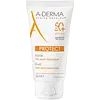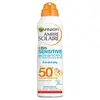What's inside
What's inside
 Key Ingredients
Key Ingredients

 Benefits
Benefits

 Concerns
Concerns

 Ingredients Side-by-side
Ingredients Side-by-side

Water
Skin ConditioningC12-15 Alkyl Benzoate
AntimicrobialMethylene Bis-Benzotriazolyl Tetramethylbutylphenol
UV FilterDiisopropyl Adipate
EmollientIsodecyl Neopentanoate
EmollientSilica
AbrasiveDicaprylyl Carbonate
EmollientBis-Ethylhexyloxyphenol Methoxyphenyl Triazine
Skin ConditioningDiethylhexyl Butamido Triazone
UV AbsorberAluminum Starch Octenylsuccinate
AbsorbentPotassium Cetyl Phosphate
EmulsifyingButyl Methoxydibenzoylmethane
UV AbsorberDecyl Glucoside
Cleansing1,2-Hexanediol
Skin ConditioningC10-18 Triglycerides
EmollientVp/Eicosene Copolymer
Acrylates/C10-30 Alkyl Acrylate Crosspolymer
Emulsion StabilisingAvena Sativa Sprout Oil
Skin ConditioningBenzoic Acid
MaskingDisodium EDTA
Parfum
MaskingGlyceryl Behenate
EmollientGlyceryl Dibehenate
EmollientGlyceryl Stearate
EmollientPEG-100 Stearate
Propylene Glycol
HumectantTocopherol
AntioxidantTocopheryl Acetate
AntioxidantTribehenin
EmollientXanthan Gum
EmulsifyingWater, C12-15 Alkyl Benzoate, Methylene Bis-Benzotriazolyl Tetramethylbutylphenol, Diisopropyl Adipate, Isodecyl Neopentanoate, Silica, Dicaprylyl Carbonate, Bis-Ethylhexyloxyphenol Methoxyphenyl Triazine, Diethylhexyl Butamido Triazone, Aluminum Starch Octenylsuccinate, Potassium Cetyl Phosphate, Butyl Methoxydibenzoylmethane, Decyl Glucoside, 1,2-Hexanediol, C10-18 Triglycerides, Vp/Eicosene Copolymer, Acrylates/C10-30 Alkyl Acrylate Crosspolymer, Avena Sativa Sprout Oil, Benzoic Acid, Disodium EDTA, Parfum, Glyceryl Behenate, Glyceryl Dibehenate, Glyceryl Stearate, PEG-100 Stearate, Propylene Glycol, Tocopherol, Tocopheryl Acetate, Tribehenin, Xanthan Gum
Butane
Water
Skin ConditioningDicaprylyl Ether
EmollientHomosalate
Skin ConditioningDrometrizole Trisiloxane
UV AbsorberEthylhexyl Salicylate
UV AbsorberDimethicone
EmollientStyrene/Acrylates Copolymer
Octocrylene
UV AbsorberButyl Methoxydibenzoylmethane
UV AbsorberPEG-30 Dipolyhydroxystearate
EmulsifyingNylon-12
Dicaprylyl Carbonate
EmollientMethyl Methacrylate Crosspolymer
Cyclohexasiloxane
EmollientPolymethylsilsesquioxane
P-Anisic Acid
MaskingTocopherol
AntioxidantSodium Chloride
MaskingDodecene
MaskingPhenoxyethanol
PreservativeThermus Thermophillus Ferment
Skin ConditioningPEG-8 Laurate
EmulsifyingEthylhexyl Triazone
UV AbsorberPoly C10-30 Alkyl Acrylate
Emulsion StabilisingPoloxamer 407
EmulsifyingIsododecane
EmollientIsostearyl Alcohol
EmollientPropylene Carbonate
SolventCaprylyl Glycol
EmollientDisteardimonium Hectorite
StabilisingDisodium EDTA
Potassium Sorbate
PreservativeLauryl PEG/PPG-18/18 Methicone
Skin ConditioningGlycerin
HumectantButane, Water, Dicaprylyl Ether, Homosalate, Drometrizole Trisiloxane, Ethylhexyl Salicylate, Dimethicone, Styrene/Acrylates Copolymer, Octocrylene, Butyl Methoxydibenzoylmethane, PEG-30 Dipolyhydroxystearate, Nylon-12, Dicaprylyl Carbonate, Methyl Methacrylate Crosspolymer, Cyclohexasiloxane, Polymethylsilsesquioxane, P-Anisic Acid, Tocopherol, Sodium Chloride, Dodecene, Phenoxyethanol, Thermus Thermophillus Ferment, PEG-8 Laurate, Ethylhexyl Triazone, Poly C10-30 Alkyl Acrylate, Poloxamer 407, Isododecane, Isostearyl Alcohol, Propylene Carbonate, Caprylyl Glycol, Disteardimonium Hectorite, Disodium EDTA, Potassium Sorbate, Lauryl PEG/PPG-18/18 Methicone, Glycerin
Ingredients Explained
These ingredients are found in both products.
Ingredients higher up in an ingredient list are typically present in a larger amount.
Also known as Avobenzone, this ingredient is a chemical sunscreen filter that provides protection in the UV-A range.
Avobenzone is globally approved and is the most commonly used UV-A filter in the world.
Studies have found that avobenzone becomes ineffective when exposed to UV light (it is not photostable; meaning that it breaks down in sunlight). Because of this, formulations that include avobenzone will usually contain stabilizers such as octocrylene.
However, some modern formulations (looking at you, EU!) are able to stabilize avobenzone by coating the molecules.
Avobenzone does not protect against the UV-B range, so it's important to check that the sunscreen you're using contains other UV filters that do!
The highest concentration of avobenzone permitted is 3% in the US, and 5% in the EU.
Learn more about Butyl MethoxydibenzoylmethaneDicaprylyl Carbonate comes from carbonic acid and caprylyl alcohol, a fatty alcohol. It is an emollient and gives skin a velvet feel. The sources of Dicaprylyl Carbonate may be synthetic or from animals.
As an emollient, Dicaprylyl Carbonate creates a film on the skin. This film traps moisture in, keeping your skin soft and hydrated.
Disodium EDTA plays a role in making products more stable by aiding other preservatives.
It is a chelating agent, meaning it neutralizes metal ions that may be found in a product.
Disodium EDTA is a salt of edetic acid and is found to be safe in cosmetic ingredients.
Learn more about Disodium EDTATocopherol (also known as Vitamin E) is a common antioxidant used to help protect the skin from free-radicals and strengthen the skin barrier. It's also fat soluble - this means our skin is great at absorbing it.
Vitamin E also helps keep your natural skin lipids healthy. Your lipid skin barrier naturally consists of lipids, ceramides, and fatty acids. Vitamin E offers extra protection for your skin’s lipid barrier, keeping your skin healthy and nourished.
Another benefit is a bit of UV protection. Vitamin E helps reduce the damage caused by UVB rays. (It should not replace your sunscreen). Combining it with Vitamin C can decrease sunburned cells and hyperpigmentation after UV exposure.
You might have noticed Vitamin E + C often paired together. This is because it is great at stabilizing Vitamin C. Using the two together helps increase the effectiveness of both ingredients.
There are often claims that Vitamin E can reduce/prevent scarring, but these claims haven't been confirmed by scientific research.
Learn more about TocopherolWater. It's the most common cosmetic ingredient of all. You'll usually see it at the top of ingredient lists, meaning that it makes up the largest part of the product.
So why is it so popular? Water most often acts as a solvent - this means that it helps dissolve other ingredients into the formulation.
You'll also recognize water as that liquid we all need to stay alive. If you see this, drink a glass of water. Stay hydrated!
Learn more about Water